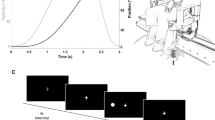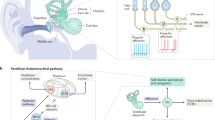Summary
Results from Bloomberg et al. (1991) led to the hypothesis that saccades which accompany the darktested vestibulo-ocular reflex (VOR) tend to move the eyes towards a vestibularly derived percept of an intended oculomotor goal: also that this is so even when that percept has been adaptively modified by suitably prolonged visual-vestibular conflict. The present experiments investigate these implications by comparing the combined VOR+saccade performance with a presumed “motor readout” of the normal and adaptively modified vestibular percept. The methods employed were similar to those of an earlier study Bloomberg et al. (1988) in which it was found that after cessation of a. brief passive whole body rotation in the dark, a previously seen earth-fixed target can be accurately located by saccadic eye movements based on a vestibular memory of the preceding head rotation; the so-called “Vestibular Memory-Contingent Saccade” (VMCS) paradigm. The result showed that the vestibular perceptual response, as measured after rotation by means of the VMCS paradigm was on average indistinguishable from the combined VOR + saccade response measured during rotation. Furthermore, this was so in both the normal and adapted states. We conclude that these findings substantiate the above hypothesis. The results incidentally reaffirm the adaptive modifiability of vestibular perception, emphasing the need for active maintenance of its proper calibration according to behavioural context.
Similar content being viewed by others
References
Bartz AE (1967) Fixation errors in eye movements to peripheral stimuli. J Exp Psychol 75:444–446
Bloomberg J, Melvill Jones G, Segal B (1986a) Quick and slow phase interaction following adaptive attenuation of the human vestibulo-ocular reflex. Can J Physiol Pharmacol 64:A3
Bloomberg J, Melvill Jones G, Segal B (1986b) Does the quick phase supplement of the goal-directed vestibulo-ocular reflex (VOR) reflect the adaptive state of a modifiable internal spatial map? Soc Neurosci Abstr 12, Part 2, p 1090
Bloomberg J, Melvill Jones G, Segal B, McFarlane S, Soul J (1988) Vestibular-contingent voluntary saccades based on cognitive estimates of remembered vestibular information. Adv Otorhinolaryngol 41:71–75
Bloomberg J, Melvill Jones G, Segal B (1991) Adaptive plasticity n the gaze stabilizing synergy of slow and saccadic eye movements. Exp Brain Res, 84:35–46
Callan J, Ebenholtz SM (1981) Effects of tilt adaptation on the direction of voluntary saccades. Perception 10:615–626
Ebenholtz SM (1984) Perceptual coding and adaptations of the oculomotor systems. In: Spillmann L, Wooten BR (eds) Sensory experience, adaptation, and perception. Lawrence Erlbaum Assoc Publ, Hillsdale NJ, pp 335–343
Feran MT, Douglas RM, Melvill Jones G (1984) Adaptation of visual-vestibular interaction without alteration of VOR or visuomotor performance. Soc Neurosci Abstr Vol 10, Part 2, p 910
Gauthier GM, Robinson DA (1975) Adaptation of the human vestibulo-ocular reflex to magnifying lenses. Brain Res 92:331–335
Guedry FE (1974) Psychophysics of vestibular sensation. In: Kornhuber HH (ed) Handbook of sensory physiology, Vol V1/2 Springer, Berlin Heidelberg New York, pp 1–154
Guedry Jr FE, Stockwell CW, Gilson RD (1971a) Comparison of subjective responses to semicircular canal stimulation produced by rotation about different axes. Acta Otolaryngol 72:101–106
Guedry Jr FE, Stockwell CW, Norman JW, Owens GG (1971b) Use of triangular waveforms of angular velocity in the study of vestibular function. Acta Otolaryngol 71:439–448
Guitton D, Volle M (1987) Gaze control in humans: eye-head coordination during orienting movements to targets within and beyond the oculomotor range. J Neurophysiol 58:427–459
Guitton D, Douglas RM, Volle M (1984) Eye-head coordination in cats. J Neurophysiol 52:1030–1050
Guitton D, Munoz DP, Galiana HL (1990) Gaze control in the cat: studies and modelling of the coupling between orienting eye and head movements in different behavioral tasks. J Neurophysiol (in press)
Hallet PE, Lightstone AD (1976) Saccadic eye movement towards stimuli triggered by prior saccades. Vision Res 16:99–106
Hansen RM, Skavenski AA (1977) Accuracy of eye position information for motor control. Vision Res 17:919–926
Israël I, Berthoz A (1989) Contribution of the otoliths to the calculation of linear displacement. J Neurophysiol 62:247–263
Ito M (1982) Cerebellar control of the vestibulo-ocular reflex: around the flocculus hypothesis. Ann Rev Neurosci 5:275–296
Kapoula Z (1985) Evidence for a range effect in the saccadic system. Vision Res 25:1155–1157
Kapoula Z, Robinson DA (1986) Saccadic undershoot is not inevitable: saccades can be accurate. Vision Res 26:735–743
Krogh E (1979) The corneofundal potential and the electrooculogram: aspects of normal physiology and variability. Acta Ophthalmol Suppl (Copenh) 140:135–141
Lackner JR, Levine MS (1981) The guidance of saccadic eye movements to perceptually mislocalized visual and non-visual targets. Aviat Space Environ Med 52:461–465
Laurutis VP, Robinson DA (1986) The vestibulo-ocular reflex during human saccadic eye movements. J Physiol (Lond) 373:209–233
Levine MS, Lackner JR (1979) Some sensory and motor factors influencing the control and appreciation of eye and limb position. Exp Brain Res 36:275–283
Lisberger SG, Miles FA, Zee DS (1984) Signals used to compute errors in monkey vestibulo-ocular reflex: possible role of flocculus. J Neurophysiol 52:1140–1153
Mack A, Fendrich R, Chambers D, Heuer F (1985) Perceived position and saccadic eye movements. Vision Res 25:501–505
Melvill Jones G (1977) Plasticity in the adult vestibulo-ocular reflex arc. Philos Trans R Soc Lond [Biol] 278:319–334
Melvill Jones G (1985) Adaptive modulation of VOR parameters by vision. In: Berthoz A, Melvill Jones G (eds) Adaptive mechanisms in gaze control. Elsevier Biomed Press, Amsterdam, pp 21–49
Melvill Jones G, Berthoz A, Segal B (1984) Adaptive modification of the vestibulo-ocular reflex by mental effort in darkness. Exp Brain Res 56:149–153
Melvill Jones G, Segal B, Katsarkas A, Bloomberg J (1988) Experiments on vestibular adaptation and its clinical significance. In: Barber HO, Sharpe JA (eds) Vestibular disorders. Year Book Medical Publ, Chicago, pp 3–23
Miles FA, Eighmy BB (1980) Long-term adaptive changes in primate vestibulo-ocular reflex. I. Behavioral observations. J Neurophysiol 43:1406–1425
Miles FA, Lisberger SG (1981) Plasticity in the vestibulo-ocular reflex: a new hypothesis. Ann Rev Neurosci 4:273–299
Poulton EC (1975) Range effects in experiments on people. Am J Psychol 88:3–32
Poulton EC (1979) Models for biases in judging sensory magnitude. Psychol Bull 86:777–803
Poulton EC (1981) Human manual control. In: Brooks VB (ed) Handbook of physiology, Vol II, Part 2. The nervous system. Am Physiol Soc, Williams & Wilkins, Baltimore, pp 1337–1389
Robinson DA (1973) Models of the saccadic eye movement control system. Kybernetik 14:71–83
Robinson DA (1975) Oculomotor control signals. In: Lennerstrand G, Bach-y-Rita P (eds) Basis mechanisms of ocular motility and their clinical implications. Pergamon, Oxford, pp 337–374
Schiller PH, Koerner F (1971) Discharge characteristics of single units in superior colliculus of the alert rhesus monkey. J Neurophysiol 34:920–936
Segal BN, Katsarkas A (1988) Goal-directed vestibulo-ocular function in man: gaze stabilization by slow-phase and saccadic eye movements. Exp Brain Res 70:26–32
Sparks DL, Mays LE (1983) Spatial localization of saccade targets. I. Compensation for stimulation-induced perturbations in eye position. J Neurophysiol 49:45–63
Viviani P, Velay J-L (1987) Spatial coding of voluntary saccades in man. In: O'Regan JK, Lévy-Schoen A (eds) Eye movements: from physiology to cognition. Elsevier Science Publ, Holland, pp 69–78
Wong E, Mack A (1981) Saccadic programming and perceived location. Acta Psychol (Amot) 48:123–131
Young LR (1984) Perception of the body in space. In: Darian-Smith I (ed) Handbook of physiology — the nervous system III. Am Physiol Assoc Waverly Press, Baltimore MD, pp 1023–1066
Zee DS, Optican LM, Cook JD, Robinson DA, Engel WK (1976) Slow saccades in spinocerebellar degeneration. Arch Neurol 33:243–251
Author information
Authors and Affiliations
Rights and permissions
About this article
Cite this article
Bloomberg, J., Jones, G.M. & Segal, B. Adaptive modification of vestibularly perceived rotation. Exp Brain Res 84, 47–56 (1991). https://doi.org/10.1007/BF00231761
Received:
Accepted:
Issue Date:
DOI: https://doi.org/10.1007/BF00231761




